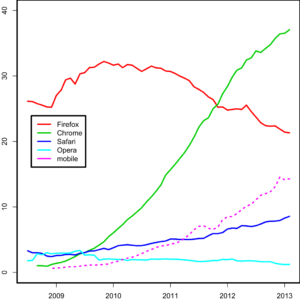During my time as a computer user from 1996, I have used almost every web browser to this date. Internet Explorer and Netscape Navigator were the two big web browsers. From my experience, Navigator ran way faster than Microsoft’s Internet Explorer. Once Navigator was purchased by AOL in 1998, I noticed a lack of updates over the next 4 years. Around 2002, Mozilla’s Firefox was released (Wkipedia, 2017). Finally, there was a web browser that worked again. In 2008, Google got into the browser game. In 2009, I started to use Google Chrome and abandoned Mozilla’s Firefox and Microsoft’s Internet Explorer. Another web browser to hit the market from 2003 was Apple’s Safari. I only used Safari during their 2007-2012 run on Windows (Wikipedia, 2017). For more information about the history of web browsers, goto: https://en.wikipedia.org/wiki/History_of_the_web_browser.
Over the years, there have been multiple ways of communication. Social networking, Email, Wikis and Blogs, Podcasts and Webcasts, and Streaming Media are all examples of the innovative ways we now communicate. Socials Networking are sites like Twitter, Facebook, Google Plus, Instagram, and MySpace. Of the five mentioned Social Networks, each are different in their own ways. Twitter is mostly used as a microblogging format. Twitter gives out information immediately. Facebook is meant for people to share photos, but it started out as a way for people to meet their fellow classmates. Google Plus and MySpace are a combination of both Twitter and Facebook. Instagram started out as a way to post pictures, but evolved into a short video and pictures. Instagram was purchased by Facebook in 2012 (Rusli, 2012) Email started between 1990 and 1995 (Moore, 2014). This became a way for people to send letter electronically. Wikis and Blogs are also ways to communicate. Wikis are websites that can be edited by visitors. Blogs, also known as web logs, are a more of a journalist sites. In other words, users cannot edit the post only the author of the post. Podcasts and Webcasts are audio or video forms of communication. Podcasts are only audio, but Webcasts, also known as Vidcasts, are video only. Webcasters are mostly known as Youtubers these days. Streaming Media examples are Spotify and Amazon Music. Both are great services, but I personally use Amazon Music with my Amazon Prime membership. For more information, please check out the follow site: http://public.wsu.edu/~campbelld/engl402/social.htm.
Mobile Commerce and Electronic Commerce have changed the ways we all shop online (Jen, 2017). Mobile Commerce, also known as M-Commerce, is a service in which the consumer purchases products with their mobile device. Electronic Commerce, also known as E-Commerce, is a service where the consumer purchases products on the internet with their computer. A great site to check out for more information is https://www.simicart.com/blog/differences-between-e-commerce-and-m-commerce/.
From: http://www.picserver.org/images/highway/phrases/e-commerce.jpg
References
Jen. (2017, May 8). 11 Key Differences Between E-Commerce and M-Commerce. Retrieved from Simicart M-Commerce Blog: https://www.simicart.com/blog/differences-between-e-commerce-and-m-commerce/
Moore, C. (2014, May 8). When did email start to become popularly used in the US? Retrieved from Quora: https://www.quora.com/When-did-email-start-to-become-popularly-used-in-the-US
Rusli, E. M. (2012, April 9). Facebook Buys Instagram for $1 Billion. Retrieved from New York Times: https://dealbook.nytimes.com/2012/04/09/facebook-buys-instagram-for-1-billion/
Wikipedia. (2017, June 24). Safari (Web Browser). Retrieved from Wikipedia: https://en.wikipedia.org/wiki/Safari_(web_browser)
Wkipedia. (2017, June 25). Firefox. Retrieved from Wkipedia: https://en.wikipedia.org/wiki/Mozilla


Leave a Reply